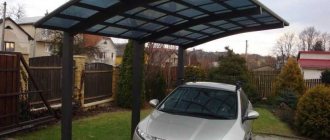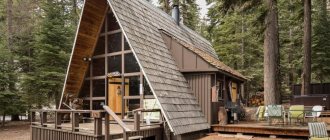Review author: Terrari School of Design
Arranging entry to the site is the next stage after the completion of the main construction and erection of the fence. It allows for full maintenance of the territory and parking for a personal car. For pedestrians, walking along a paved path to the house is much easier and more pleasant than walking off-road.
Entry width
The organization of an access road to a site begins with determining the width of the entrance. The reporting point is the turning radius. The entrance must be of sufficient width, even if the road is narrow. The recommended width is four meters as a minimum. This is necessary so that heavy equipment (excavator, concrete mixer, tractor) can freely enter the site without hitting the gate. The dimensions of the equipment should be calculated in advance. It must be remembered that the turning radius of heavy trucks reaches 10 meters, the length of a truck with a trailer in some cases reaches 13 meters.
You also need to pay attention to the height of the gate Source 24aul.ru
Types of gates
Swing gates
The dimensions of gates for a private country house depend on the design. The following models are distinguished:
- Swing - when opened, the doors swing open, turning on hinges. To do this, you need free space, which creates a number of inconveniences: trees and bushes cannot be planted near the opening, open doors interfere with passage, and gates block the view of the motorist. However, this option is affordable, can be installed by yourself, and is therefore popular.
- Sliding - the door leaf moves along the fence to the side. To open, space around the opening is not required, but a free section of the fence is needed. This is much easier to do, since according to SNiP standards, even bushes are planted at a distance of at least 1 m from the fence. The disadvantage of this solution is the possibility of freezing of the roller mechanism and contamination of the guides. These elements should be cleaned quite often.
- Lifting - when opened, the sash rises, bends and takes a horizontal position at a certain height. They rarely set up a garden plot: the guides and roller mechanism here get dirty even faster. However, such gates are very resistant to burglary and can be an important element of home security. They do not need to be insulated.
- Roller shutters - the canvas consists of narrow slats. When opened, the sash is rolled up and hidden in a box. This design does not take up any space at all, does not limit the view and is much lighter than a sectional one. However, the reliability of a roller shutter is lower than that of a sectional or forged one; it is much easier to damage such gates with an impact. In addition, the box limits the height of the passage, which is not always acceptable.
Lifting garage doors
Sliding gates
Rolling garage doors
It is extremely rare for lifting models to appear in summer cottages. Here the canvas does not bend during lifting and rotates to a horizontal position as one plane. This design is quite bulky and difficult to maintain.
Regulatory conditions
Where exactly the exit to the territory will be located, the owner decides independently. However, there are general requirements that cannot be ignored. The arrangement of the entrance must comply with SNiP standards. The following parameters are distinguished:
- The entrance to the site must be at the same level as the road.
- The width of the entrance must be at least 4 m, the width of the site at the junction with the road must be at least 8 m.
- The entrance should not interfere with traffic on the main road.
- If there are drainage systems along the road, they should remain intact.
- When laying drainage, the recommended pipe diameter is 30 cm, length is 4.5 m.
- The slope of the pipe should be at the same level as the slope of the trench.
If the entrance to the site is through a ditch, then it is necessary to arrange drainage Source ddacha.ucoz.net
Before starting the arrangement of the entrance, you need to familiarize yourself with the building codes in force in the village and the HOA. After the construction of the access area to the house, the road capacity should not deteriorate.
Functions
The main purpose is to provide a convenient access route for the cars of the owner of the house, his family members and guests from the street to the yard, so that they do not get stuck in bad weather.
An additional function can be identified as aesthetic. The pleasant impressions of guests will be enhanced if, for example, they drive across a mini-bridge decorated with wild stones.
Technology for arranging entry to the territory
Equipping an entrance is not difficult if the land plot is located on flat ground. The presence of elevations, hills and ravines complicates the situation. If the site area has an uneven surface, the following options for arranging the entrance are possible:
- entry through a ditch;
- with drainage system;
- downhill drive.
Before constructing the road, it is recommended to lay the drainage system. This will help protect the soil from waterlogging and thereby prevent the road from becoming soggy during the rainy season.
Temporary crossing over a ditch Source naidimastera.ru
See also: Catalog of companies that specialize in designing and performing landscape work of any complexity
Entry through a ditch
First you need to purchase a pipe to drain the water. In the store you can buy metal, concrete and plastic pipes. The last option is preferable. The cost of plastic is low, moreover, it is lightweight, easy to install and does not corrode.
Construction of drainage consists of the following steps:
- In the place where the entrance will be, it is necessary to dig a ditch at least 2 meters wide and at least one meter deep.
- A pipe is laid on top. The length of the pipe depends on the width of the entrance area; in general, it should be at least 4 meters.
- Sand and crushed stone are poured into the bottom of the ditch and the mixture is compacted well.
- The structure is covered with crushed stone to the very top.
- To prevent debris from getting inside the cavity, the outlet openings are covered with bars made of reinforcement.
If concrete mortar is used instead of crushed stone, formwork made of reinforcing steel rods with a diameter of 1.5 mm is placed around the pipe. After the solution has hardened, the formwork is dismantled.
Arrangement of passage through a ditch with a concrete pipe Source savoya-land.ru
Drainage system
If the site is located on a hill, it is not necessary to lay the pipe in a ditch. In arid climates, a simple drainage pad is sufficient.
In this case, the ditch should not be deep. A depth of 50 cm is sufficient. The edges of the ditch need to be reinforced with a layer of crushed stone, stones and concrete. A strong reinforced concrete slab is placed on top of the ditch.
Entry on a slope
When the entrance to the territory is located on a slope, it is necessary to provide for unforeseen situations. Spontaneous movement of heavy equipment, towing and wheel slipping can lead to unpredictable consequences. If the angle of inclination is large, the site is leveled as much as possible. In this case, it is advisable to arrange the entrance along a curved trajectory. This will help reduce the magnitude of the difference. A turning area must be provided in front of the gate.
Thoroughly equipped entrance to the site Source fermersadovod.ru
Bridge made of reinforced concrete slabs
To create a crossing over a narrow ditch, many people do this simply:
- compact the soil in the areas where the slabs adjoin;
- purchase ready-made slabs and order crane services;
- Using a crane, the slabs are placed in their places.
The disadvantages of this method are also significant. These include:
- the possibility of gradual subsidence of the structure and the appearance of cracks between the slabs on soft soils;
- not aesthetically pleasing.
Coverage for entry to the territory
During construction, heavy equipment loaded with bricks, cement, etc. passes through the entrance gate. The surface of the area in front of the gate is subjected to daily intense loads. To extend the service life of the coating, the choice of building material must be taken responsibly. High-quality coating meets the following requirements:
- vibration stability;
- waterproof;
- resistance to temperature changes;
- ability to withstand loads.
Based on the above parameters, the entrance coating can be bulk (gravel, crushed stone) or monolithic (reinforced concrete slab).
Equipped entrance to the site Source vdvrus.ru
Requirements for design parameters
In principle, any building materials can be used for the construction of this structure. The main thing is that the resulting design:
- easily supported the weight of the heaviest car in the family. Since there are situations in life when a truck will have to drive into the yard, it is highly desirable that the structure have a safety margin;
- was durable. Metal and wooden elements must be adequately protected from corrosion and rot;
- have a pleasant appearance.
Briefly about the main thing
Before starting any construction work on a plot of land, you need to think about what kind of transport will transport building materials to it, and whether a crane or other heavy equipment is needed at the construction site.
In any case, it is necessary to inspect the road in advance and assess whether the required transport can pass along it and whether additional work will be needed to prepare the passage routes. If you neglect this, then there is a possibility that these issues will be resolved at the moment when the equipment has already been rented, which can significantly increase the estimate.
Ratings 0
Wooden bridge
Some owners make bridges from sleepers or timber. The disadvantage of this material is its relative fragility.
To increase service life, it is necessary to impregnate lumber with antiseptics, or at least with waste oil.
Presence of expansion joints
Expansion joints are a mandatory attribute not only of monolithic sites, but also of roads and paths. Naturally, a reinforced concrete slab does not have such seams, but during road construction they are obtained naturally. When constructing monolithic coverings, expansion joints are combined with technological joints. The gap between the slats is selected based on the amount of capture of one fill. When the formwork is installed, as well as the reinforcing frame, wooden slats are laid at the seams.
The slats are laid:
- Flush with the road surface, and also taking into account the angle of inclination of the surface to form water drainage. Reiki can also be used as beacons.
- The width of the slats is about 15-20 mm, and their height is at least 4 cm if the concrete thickness is 16 cm.
- The slats are located at a distance of 4 meters from each other. Typically this distance corresponds to 25 times the thickness of the concrete.
After 4 hours, the concrete is covered, otherwise it will lose some of the moisture.
The slab is opened after the expiration of the two-week period. The slats are removed from the concrete, and the resulting space is filled with bitumen mastic, with 20% filler in the form of sand and small gravel.
Coordination of ditch crossing arrangement
First of all, it is necessary to agree in writing on the crossing arrangement with the owner of the ditch or with the service organization. The owner may be a dacha or gardening partnership. Maintenance is most often carried out by road services. If there is no information on this matter, then you need to contact the municipal administration. All roads and structures for their maintenance are on the balance sheet of municipalities.
If the municipality declares non-involvement and does not know the owner, let it report this in writing to the request for approval. Then no one will be able to hold them accountable for arbitrariness and damage to hydraulic structures. This is how such objects are listed in the register of owners.
In response to the request, conditions and requirements must be issued; they can be called technical conditions that must be fulfilled and observed during the construction of the crossing.
They must contain conditions on the need to organize the passage of water, or allow the absence of a collector. For example, if there is no drainage when draining the area. The minimum pipe cross-section size and pipe type are indicated. As well as requirements for filling and strengthening the embankment. Specifications may contain other requirements. For example, notify about the completion of work and hand over the object according to the act.
Manifold material
For such purposes, thick-walled metal pipes were mainly used. In addition, the industry produces reinforced concrete pipes of various configurations (square, round, U-shaped), including small sizes.
These pipes are quite heavy and require special transport to transport them.
Recently, in such cases, plastic pipes, non-pressure corrugated, consisting of two layers, have been used. Their cross section is from 10 cm to 1 meter. And although the standard length is 6 meters, sellers cut off the required piece of pipe. When choosing, it is important to take into account the ring stiffness class of the pipe. If you adhere to laying technology, the pipes can withstand significant loads. Service life - from 50 to 100 years. Today this is the best choice.
Interior design
After ensuring safe entry, it is necessary to begin decorating the interior space. This is a serious undertaking that involves working with the landscape and developing a landscape design project.
Important!
The inside does not have to be a continuation of the outside driveway, but if the outside is covered with paving stones, then it can be continued further.
Inside, it is necessary to make not only a “road” for the car, but also a branch to the parking space, so the driveway must be adjacent to the garage door or a specially designated space.
As decoration, you can use a variety of borders, forged metal structures, decorative ponds and other landscape delights that are available to the owner and match the design of the yard.
Check-in of their monolithic reinforced concrete
The road trough, in contrast to the option described above, is arranged to the side of the road without a slope from the axis. The work is carried out according to the following scheme:
- Sand is poured into the trough, leveled, watered and compacted.
- Next, a layer of crushed stone of medium fractions is poured. The layer is up to 15 cm thick. The crushed stone is leveled.
- A layer of fine crushed stone is poured on top. Its thickness is up to 5 cm, but take into account that when leveling, most of the fine crushed stone will be used to fill the voids. The material is leveled and compacted.
- Install the formwork. Reinforcement is performed. The concrete solution is poured, the concrete is compacted and left for 2-3 days.
- Then the formwork is removed and curb stones are installed.
- The surface of the concrete is covered so that moisture does not evaporate quickly.
The concrete is periodically watered until it reaches brand strength. This usually takes 28 days.











